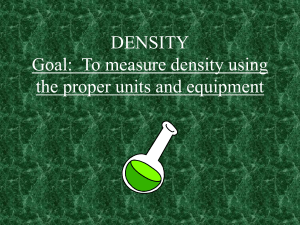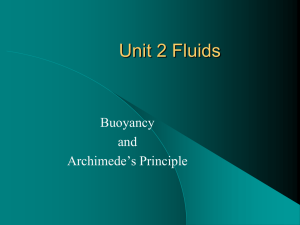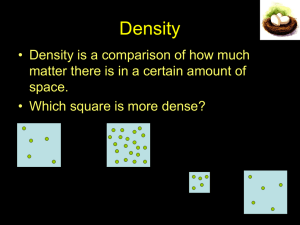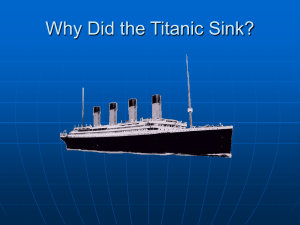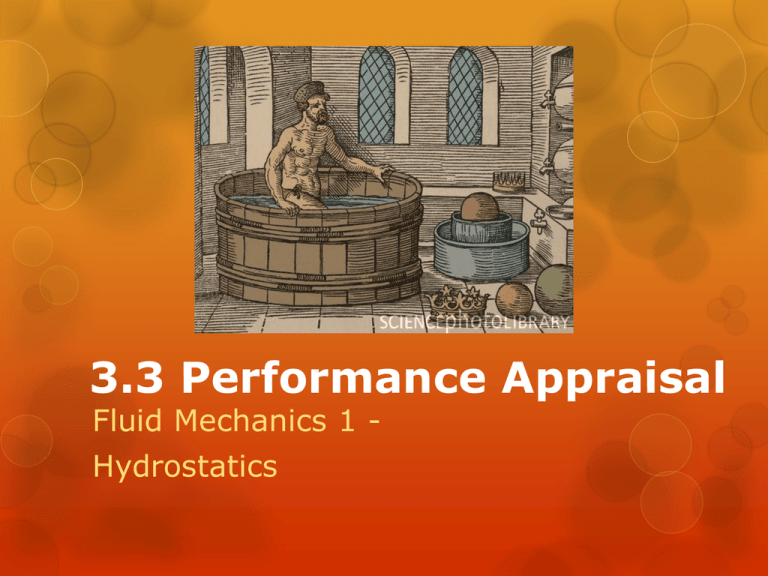
3.3 Performance Appraisal
Fluid Mechanics 1 Hydrostatics
Prior Learning:
Functional Anatomy
• Bones
• Muscles
• Movement at joints
Biomechanics
The science that examines the internal and external forces acting
on a human body and the effects produced by these forces.
•
•
•
•
•
Balance, stability and centre of mass
Levers and projectile motion
Inertia
Force and force summation
Momentum
Fluid Mechanics
refer to forces which operate in water and air.
This unit will only look at the forces operating in water.
Hydrostatics
Fluids at rest and under pressure
Consider these aquatic-questions…
1. Why does a plank always adjust it’s position in water to float
horizontally, not vertically?
2. Why, if you had an aluminium dinghy and a block of aluminium
the same weight, the dinghy will float and the block sink?
3. When they try to float on the surface without moving some
people manage it easily while others always sink. Why?
4. Why is it easier to pick up and hold an object in water than
doing it on land?
Buoyancy & Floatation
An individual who floats is said to display positive
buoyancy
Others tend to sink in the water and display
negative buoyancy
Introduction to why things float...
A person’s ability to float may influence
performance at both the beginner and
championship levels
Beginners who have positive buoyancy are likely to
learn to swim faster than those who float with
difficulty, or not at all
The Archimedes Principle
The reason why one object floats better in the water than another
is determined by Archimedes Principle of Forces which states that:
‘A body submerged in a liquid is buoyed up by a force equal to
the weight of the fluid displaced’
This means that an object will float in a fluid if its density is less
than the density of that fluid.
• The density of fresh water is 1.00, and if an object has a
density of less than this it will float
• If the object’s density is greater than 1.00 it will sink
• Also known as the ‘specific gravity’ of an object
• The effective specific gravity of the human body is 0.95
Implications
This means that in general the human body has the ability to float
A lump of steel will sink because it is unable to displace water that equals
its weight
But steel of the same weight but shaped as a bowl, will float
This is because the weight gets distributed over a larger area and the
steel displaces water equal to its weight
A heavily laden ship floats because its total weight is exactly equal to the
weight of the water it displaces
It is this weight that exerts the buoyant force supporting the ship
Additional Movie
Factors affecting floatation
Lung Capacity
The volume of air in the lungs has a pronounced effect on an individuals
ability to float
Deep inhalation = considerable volume of air added to lungs = specific
gravity reduced substantially
The majority of males and females will float if they have taken a full
inhalation of air
But the majority of males will sink unless they have more than residual air
in the lungs
Body Build
Individuals with a high fat content will tend to be good floaters when
compared with those who are heavily boned and well muscled
This is because of the specific gravity of body tissue:
Bone = 1.5 – 2.0
Muscle = 1.0
Fat = 0.8
Endomorphs – overweight = floater
Mesomorphs – little fat, high proportion muscle, bone = sinker
Ectomorphs – slim, slight = floater
Factors affecting floatation
Sex
Females tend to have greater proportions of fat which aids their floatation
because it lowers their specific gravities (mushroom test)
(Controllable Factors)
Muscular Tension
Can disallow the lungs to fill with air adequately, having a negative effect
on floatation
Reduction in Buoyancy Force
The upward buoyancy force is reduced whenever a part of the body comes
out of the water, therefore swimmers should keep as many parts in the
water as possible
Centre of Buoyancy/Centre of Gravity
Many individuals have the ability to float but cannot assume a horizontal
body position as the legs tend to sink
This is because in air, the body rotates around the COG, while in water
the axis of movement is the COB
The actual floating position for a human body is when the COG is
vertically aligned with the COB
The legs sink until the COG (hip region) and the COB (lung region)
come into vertical alignment
This is why a person with a COG higher up in their body has dragging
legs, creating a lot of drag
(See notes for more detailed explanations)
DVD on Fluid Mechanics?
Student Task
Explain, in detail, how
the Archimedes
Principle affected your
original performance in
swimming.




